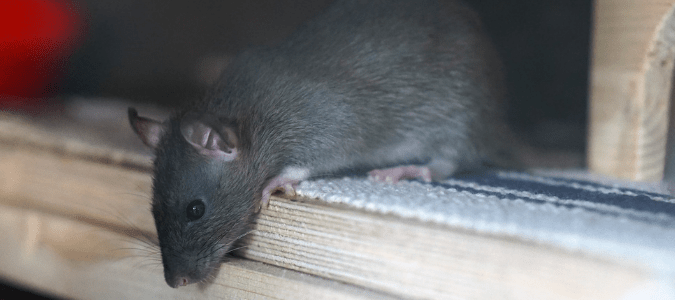There Are Rats in My Ceiling: What Can I Do?

Hearing squeaking or scratching sounds coming from your ceiling can be puzzling. What could be making that noise? The unpleasant truth is there are a variety of creatures that could be up there. It could be anything ranging from rats or mice to squirrels or even raccoons. When it’s cold outside and regular food supplies are scarce, animals might seek shelter wherever they can find it. Often, this means moving in with humans.
If rats are in your ceiling, you will likely want to contact a professional. Rats in your ceiling could indicate that they have built a nest and started reproducing. Unfortunately, these creatures are capable of reproducing at an alarming rate. Their numbers could grow exponentially and they can cause extensive damage to your home.
If you believe rats might be nesting in your ceiling, check for these signs:
- Squeaking or scratching noises coming from your ceiling or from within your walls.
- Droppings, which are elongated brown pellets with rounded ends. These droppings measure between a third of an inch to a half of an inch in length.
- Gnaw marks on wood and belongings as the rats try to chew items to shorten their evergrowing teeth.
- Shredded materials, such as cloth, as rats collect materials to build nests.
- A musky smell in attics and other enclosed spaces.
- Greasy smudge marks on walls, rafters, beams or other areas where the rats are traveling.
- Rats themselves, whether they are alive or dead.
Squeaking and scratching sounds are some of the most common signs that there are rats in the ceiling. If you’re able to look in your attic or the space where the sounds are coming from, you may see these other signs. For example, you might find gnaw marks on wood or drywall. Rats and other rodents have continuously growing front teeth. To keep their teeth short, they will gnaw on almost any material they can find. This includes wood, drywall and even electrical wiring. This is one major source of the destruction these pests can cause in a home.
You might also see evidence of a nest, such as shredded leaves, paper, cloth, twigs and other materials. Rat feces are another common sign of rat activity.
Rats are unwelcome for a variety of reasons. Perhaps the most obvious is the damage they can cause if allowed to nest and breed. These rodents are also known carriers of over 35 diseases, including hantavirus and leptospirosis. These diseases can transfer to humans via contact with the rat, live or dead, or with its urine or feces. Humans can also contract diseases if they are bitten by a rat or if they are bitten by a flea or tick that had fed on a rat.
Rats are also prolific breeders, which is yet another reason is why it’s important to control a rodent problem as quickly as possible. Pest control specialists are trained in spotting the signs of a rat infestation. These professionals also know the most effective tools and techniques to remove these creatures, and can help prevent rats from returning.
There are steps you can take to keep rats away from your home and yard. General upkeep and sanitation go a long way, both inside and out. If you want to know how to keep mice out of your bed, your first step will be making your yard less attractive to rodents and wildlife by following these steps:
- Keep your yard clear of dead trees, branches and other vegetation. This will limit spaces where rats could build a nest. Also, trim tree branches so they aren’t close to the roof of your home. Rats commonly get into homes by climbing from tree branches on to roofs.
- Store garbage and compost piles in bins with well-fitting lids.
- Keep your kitchen clean and store food in airtight containers. Pet food should also be kept in containers with tight-fitting lids, and you should only leave your pet’s food out as long as needed.
- Close off access points to your home that rats might use to gain entry. These animals can squeeze through surprisingly tiny gaps around vents, hose bibs, doors, window frames and in eaves. You can close holes or cracks with wire mesh, caulk or other materials to prevent pests from getting in.
While many homeowners try do-it-yourself methods of rodent control, these efforts typically yield minimal results. As previously mentioned, rats are prolific breeders, so even if you’re able to catch a rat or two with traps you set yourself, you’re likely only slowing the population growth. Also, hoping your dog will keep rodents away is unfortunately just wishful thinking and not enough to get a population under control.
If you’re struggling with rats, it’s time to contact a reputable pest management specialist for help. These professionals can determine the exact nature and scope of the problem. They will also be able to come up with the best approach for removing the pests and keeping them from returning. A professional can take measures to rodent-proof your home, and can recommend ways to make your property less hospitable to these creatures.
If you suspect you have a rat problem, you’re probably wondering how to catch a rat in the house. Keep reading for more information on how to deal with a rodent problem.

How To Catch a Rat in the House
Rat traps can be effective for you to set on your own, but only if you’re dealing with a small number of rats. And, given how quickly rats reproduce, their numbers can grow quickly as you try various methods in an attempt to gain control of the situation. Unfortunately, this means that do-it-yourself rodent control usually isn’t the most effective option. That said, if you do choose to set up a few traps while you wait for a rodent control specialist, there are a few things you should keep in mind.
Careful placement is key with rat traps. They must be set in out-of-the-way places where household pets or children won’t come across them. Traps should also be placed in areas where the rats commonly travel, such as along rafters or beams. When setting traps, it’s important to wear gloves. This is because if the rats smell your scent on the traps, they will avoid the traps.
Keep in mind that you must check the traps on a regular basis. You will need to replace your bait every week or so to keep it appealing to rodents. Baits that work well for rats include proteins like peanut butter, turkey and hot dog slices.
Another reason to check your traps on a regular basis is that if a trap works as intended, the dead rat will soon begin to stink. It’s important to take caution when disposing of a dead rat. Even dead rodents can carry diseases that can make humans very ill. This is yet another reason why rodent control is better left to the professionals.
If you’ve been using rat traps and they don’t seem to be helping, the wisest next step is to contact a professional. Professionals can determine whether you have a rat problem or another type of wildlife problem. They can create a comprehensive approach to eliminating any type of pest on your property. Also, they can prevent these insects and critters from returning in the future. This way, you can have peace of mind.

Do Rats Carry Diseases?
Many people wonder: “Do rats carry diseases?” The simple answer to that question is yes. Rats do carry diseases—over 35 of them, which is many more than many homeowners would expect. Sadly, many of the diseases that rats carry are dangerous ones that can make humans and their pets very ill. Three of the most common diseases rats can transmit to humans are hantavirus, salmonella and leptospirosis. These rodents are also able to transmit a host of other infectious diseases to humans and other animals. Rats even carry bubonic plague. Yes, that’s the very same pandemic that decimated populations across Europe during the Middle Ages.
Rat droppings, urine and saliva are all able to transmit these diseases to anyone who comes into contact with them. Fleas and ticks that feed on rats can also transmit diseases to humans through their bites. And, rats can actually bring fleas and ticks into people’s homes. Then, these pests can transmit secondary diseases like Lyme disease. For all these reasons, it is extremely important to handle rats, both living and dead, with great care. If you are clearing out a nest or cleaning up rat feces or urine, it’s a good idea to wear protective gear such as gloves, goggles and a mask.
Pest management specialists having the training and equipment to properly handle rodent infestations. They can also make the home a less likely target for wild rodent pests in search of food and shelter. Of course, one of the biggest benefits of hiring a professional is they can use a holistic, whole-property approach to address the problem.
Many people who initially try a do-it-yourself pest control approach find that it quickly spirals out of control. This is because most of these techniques are not scientifically proven. To make matters worse, the rats breed so quickly that their population seems to explode. It’s often a good idea to save time and effort by contacting a pest control professional.
Chem-free Can Remove Rodents From Your Property
Unfortunately, rodent populations can quickly grow out of control. For an effective, low-impact approach to rodent control, contact Chem-free Organic Pest Control. We create our pest control plans with your children’s well-being in mind, as well as your furry family members. Our specialists will be able to locate all rodent hiding spots. Then, we will remove them from your property, so you don’t have to worry about any more unwanted house guests.

